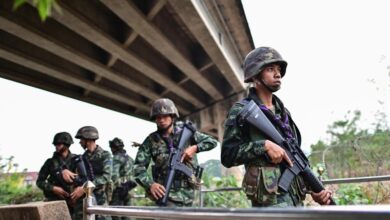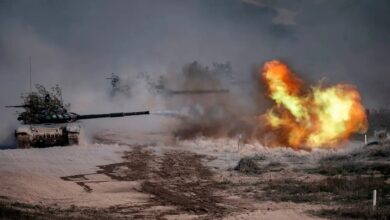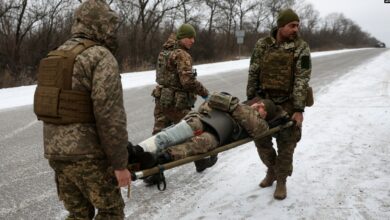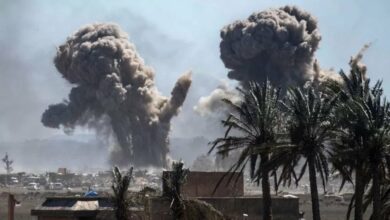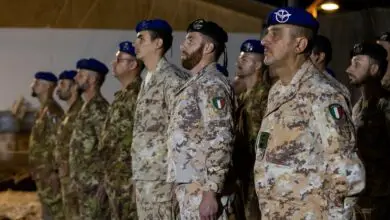Russian troops enter Syria’s Raqqa, filling void of withdrawing US forces
Russian military forces moved into Islamic State’s former de facto capital Raqqa in northeast Syria following an agreement with the local Syrian Democratic Forces to fill a void left by the hasty withdrawal of U.S. Special Forces from the area.
The Russian Defense Ministry’s Zvezda TV showed Russian soldiers distributing humanitarian goods in the area on Monday, December 9, Reuters reported.
The deployment is the latest example of pro-Syrian government forces moving into key areas of Syria’s northeast, which the SDF backed by the U.S.-led Coalition against ISIS captured from the group starting in 2015.
The Coalition’s arming of the SDF, the core of which consists of the predominately-Kurdish People’s Protection Units (YPG) militia, angered the Turkish government, which considers the YPG a terrorist organization.
Turkey launched its own military operation, dubbed Operation Peace Spring, across Syria’s northeastern border against the YPG on October 9, leading American forces to pull back to get out of the way. U.S. troops left key cities such as Manbij and Raqqa in recent weeks.
Turkey’s incursion, which has killed hundreds of people and displaced more than 100,000, has so far has been limited to the area between the Syrian border towns of Tal Abyad and Ras al-Ayn. The U.S. has made clear it will not use military force against NATO ally Turkey to stop the attacks.
‘The SDF needs Russia’
The SDF’s top commander, General Mazlum Abdi, met with Russian Lieutenant General Alexander Chaiko earlier this month, forging an agreement “on the deployment of Russian forces in Amuda, Tel Tam[e]r and Ain Issa,” he wrote on Twitter.
“We look forward to further joint efforts for the benefit of our two countries,” Mazlum wrote.
U.S. officials had initially discouraged Mazlum from cutting any hasty deals with Russia or the Assad regime following President Donald Trump’s decision to allow Turkey’s incursion, though it is unclear if the U.S. position has since changed.
The Assad government, which is backed by Russia in Syria’s eight-year civil war, accuses the SDF and its affiliated governance structure of separatism – a charge adamantly denied by northeast Syrian authorities – and demands the autonomous region’s full capitulation to centralized political control under Damascus.
In October, the SDF invited a limited number of Syrian pro-government troops into the northeast to slow Turkey’s attack following the White House’s announcement that American forces would get out of the way of the invasion.
“We did not wait for [William] Roebuck’s response,” a senior official with the SDF’s political wing told The Defense Post from Syria, referring to the State Department official who discussed the matter with Mazlum as the incursion began. “It was what it was.”
A State Department spokesperson told The Defense Post via email that the SDF informed U.S. officials on the weekend of October 12-13 that its leaders had reached an agreement with Russia and the Assad government “on security arrangements in parts of northeast Syria from which the U.S. was withdrawing.”
The U.S. redeployed its forces, withdrawing from bases near key northeastern cities like Kobani, Manbij and Ain Issa in order to defend oilfields under SDF control in Syria’s east. The region’s oil is a strategic prize coveted by the Assad government and Russia.
The withdrawal left Washington with little leverage over SDF decision-making in areas of northeast Syria which its forces abandoned, said Aron Lund, a fellow at The Century Foundation.
“The SDF needs Russia to make the Turks stop,” Lund told The Defense Post.
Turkey considers the YPG to be inextricably linked to the Kurdistan Workers Party (PKK), which has waged a decades-long insurgency in Turkey. Turkey’s President Recep Tayyip Erdogan has vowed to destroy the organization and purge affiliated political personnel from the border region.
“Russia is not going to try to do that unless the SDF gives something back – most probably, by conceding power or land to Assad’s government, and perhaps in some areas also to Turkey and its Syrian rebel allies,” Lund said.
There are also reports of Russian troops in Ain Issa, the seat of the northeast’s Autonomous Administration, suggesting Russia’s growing foothold in the northeast may translate into greater leverage in this corner of Syria’s conflict.
“What seems to have happened here is that Russia is brokering arrangements for the limits of the Turkish zone in northeastern Syria,” Lund said. “Russia wants to be the referee but is simultaneously forced to be a player.”
Russia and Turkey signed a deal on October 22 to see Russian military police and Syrian border guards “facilitate the removal” of SDF from border areas in accordance with Turkey’s demands, a day before Russian military police conducted the first patrols in border areas.
That deal followed an earlier U.S.-Turkey agreement under which Turkey was to temporarily halt its assault on northeast Syria in order to give the SDF time to withdraw from part of the border, though Turkey-backed rebels have continued to press the attack on the ground.
“Turkey has been pushing to win more land, cities and access to the M4 [highway],” said Lund, but “they’re more interested in making sure that the SDF is dismantled, weakened and wrapped up into Syrian government control.”
“By attacking, they have been strengthening their hands in these talks,” Lund said.
Many of the limited number of Syrian Arab Army that moved into the northeast in October were ill-equipped and proved weak on the battlefield.
YPG personnel just a few kilometers behind the Tal Tamr frontline last month complained to The Defense Post that SAA forces sent by Damascus were unprepared, confused and without adequate firepower against Turkey’s forces.
A source close to northeast Syrian leadership, who was not authorized to speak publicly on the matter and requested anonymity, said some SAA soldiers had been asked SDF fighters for food.
While a Russian presence brings the firepower and political clout needed to deter an expansion of Turkey’s incursion, the SDF’s political wing has expressed doubts as to Moscow’s true intentions.
In spite of the chaos, the SDF and Coalition resumed major counter-terror operations against ISIS sleeper cells in mid-November.
The YPG, according to Nicholas Heras, a fellow at the Center for The New American Security, “have to play a weak hand strongly.”
“If they can continue to have the U.S. dependent on them to counter ISIS, then that at least gives them some type of leverage,” Heras said.
Though U.S. forces have pulled back to the eastern side of Syria’s autonomous region, their nearly untouchable presence around the area’s oilfields grants Washington a final sliver of leverage in the conflict.
And with Washington’s blockade against Assad’s economy in full swing, Syria’s currency is plummeting, leaving room for the chance that Russia may offer the YPG an option other than full surrender to Damascus, Heras said.
Still, a number of battlefield and political arrangements remain unresolved, and with so many actors in play, the outcome of this chapter of the war is still uncertain.
“There are a number of issues at stake, including who should control the M4 road that bisects the area, who gets to be where, and what sort of control the Syrian government will have over SDF-backed local authorities,” Lund said.
“Ultimately, Turkey is the actor that can spoil everything,” Heras said. “All it takes is for Erdogan to decide that he does want a maximal zone of control, stretching from the Euphrates to the Tigris, to make it untenable.”


